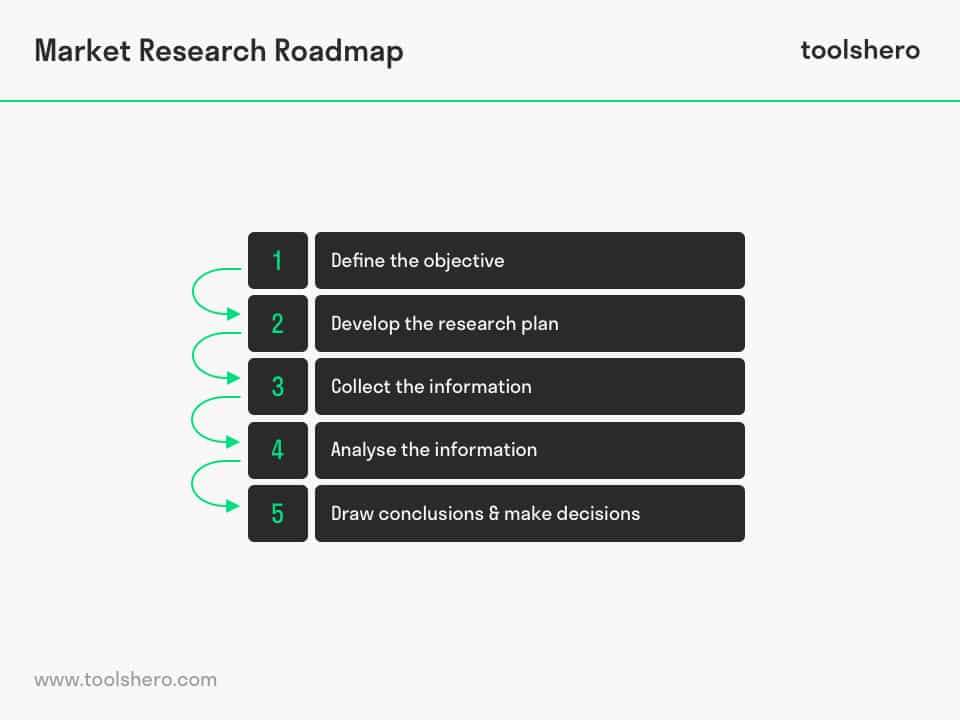Market Research: the Basics and Tools

Market Research: this article provides a practical explanation of Market Research. This article covers the definition and meaning, an explanation of the different types and tools of market research, and practical tips. After reading you will understand the basics of this marketing analysis tool. Have fun reading!
What is Market Research?
Market research refers to the systematic collecting and analysing of information on individuals – e.g. consumers and organisations – and products and services in current and future markets. Market research uses statistical and analytical methods to gain insight into the reasons and motives that influence consumers’ decision making.
These statistical and analytical methods are used in combination with social, data, and behavioural sciences. One of the things it tries to clarify is consumers’ spending patterns, as well as specific demographical, geographical, and psychographical date about the target audience and competition the organisation will have to face.
The planning and actually carrying out of this method is part of the core discipline of any marketing team. The results from the market research may, for instance, help guide the development team to develop products that offer new solutions for the consumer.
The first evidence of market research dates back from medieval times. The German textile manufacturer Johann Fugger travelled from Ausburg to Graben in the 15th century to learn information about the international textile industry. One of the things he did was write letters about his trading terms and his target audiences.
Although this type of information was called commercial intelligence in those days, it would now be described as systematic collection of market information.
Types and tools of Market Research
Market research covers many disciplines and fields of study, which are therefore often poorly understood. Generally speaking, market research can be divided into several types of research.
Market Research: Qualitative Research
In order to look into the minds of consumers, you must conduct qualitative research. To gain insight into product choices, the market, and opinions and motivations of consumers, you could use interviews, for example. Qualitative market research goes beyond just finding out what the consumer is thinking.
It is about giving the researchers an idea why people think like they do. This deeper feedback can be obtained in group discussions, interviews, on message boards, etc. Qualitative market research is used for things like developing new products or coming up with new marketing initiatives. In short, qualitative research make it possible to answer useful questions, such as:
- What does the consumer think of the product or service?
- How do customers choose between different products and suppliers?
- What effect does brand, design, and packaging have?
- What is the consumer willing to pay for the product or service?
Market Research: Quantitative Research
Quantitative market research involves asking people’s opinions in a structured way. This makes it possible to collect facts and statistics based on answers. In order to ensure that the conclusions drawn from this are representative, it’s important to include large numbers of respondents in the research.
Techniques used in quantitative research include things like surveys and questionnaires. Companies distribute these to improve their products and services using the feedback they get. Questions that quantitative market research may help answer include:
- Is there a market for the product or service and how big is it?
- Are people aware of it?
- Are consumers interested in the product or service?
- What kind of people are our consumers?
- Are the needs and wishes of the target group changing?
Primary Research
Primary market research is based on an organisation’s needs, making it pretty specific. This type of research is either carried out by the organisation itself or outsourced. Examples of primary research include interviews, observations, tests, and focus groups.
Primary research enables the organisation to gather relatively specific information, interests, and feedback on topics like their website, demand for a certain product, rating of the customer service, packaging options, etc. The downside of primary research is that the costs can be quite significant. Luckily, there are a lot of free online tools available these days, for instance to create surveys.
Secondary Research
In secondary research, information is gathered from earlier studies by institutions like the government, the chamber of commerce, trade associations, and more. Unlike with primary research, the information is often not as relevant because no specific research question is developed that is based on the actual needs of the company.
On the other hand, secondary market research is a lot cheaper or even free. Secondary market research can be found in newspapers, online, in libraries, or on business websites.
Market Research Roadmap
Although market research can take many forms, there is a basic roadmap to do it. Below is an explanation of five steps from such a roadmap.

Figure 1 – Market Research Process and Roadmap
1. Define the objective
As with any project, it’s important to first define the objective or the problem. The problem has to be defined accurately. Vague problem definitions may result in a waste of precious resources. If a problem is too specific, it might not be possible to draw an exact conclusion.
Ask the following questions: What needs to be researched? Why does the research need to be done and what important decisions will have to be made? Some business challenges that are often found in market research include: How should we price this new gadget? What features should be prioritised? Etc.
2. Develop the research plan
Now that the problem or objective has been defined, it’s time to find out what information is required to solve this problem. The research plan should describe which sources will be used, for instance.
Will you only use primary research? Or combine it with secondary sources? These secondary sources are usually available, but in the case of primary research, a plan has to be made on how to gather this data.
3. Collect the information
Data gathering is the most time-consuming and often expensive step in the research process. This is true for both quantitative and qualitative data. The answers from surveys and questionnaires, observations, and opinion polls are all recorded in a spreadsheet. This way, each spreadsheet contains a treasure trove of information that will be an important part of the conclusions that will be drawn in later steps.
4. Analyse the information
Now that the information has been gathered, it has to be organised to allow it to be analysed. Researches then apply different statistical methods and techniques, such as calculating averages, the spread of answers, etc. Data is analysed using technical tools such as statistics software like SPSS, Excel Minitab, etc.
These instruments can be used to easily create tables and graphs. These can then be segmented into logical groups, such as demographic data or geographical data to subsequently draw conclusions for each part of the research.
5. Draw conclusions & make decisions
The final step is to put the take-aways and recommendations in a clear report or presentation. Start with the research goals as defined in step 1. Next present the recommendations based on the date that was found while researching solutions to the problem.
These findings are often presented to upper management, such as a board member, the CEO, or the entire board of directors. It is now up to them to decide whether the findings are concrete and accurate enough or if they are deemed unsuitable and therefore should be dismissed in the recommendations.
Now it’s your turn
What do you think? Are you familiar with this explanation of market research? How have you shaped the market research process in your own company? How do you think you’ll be able to use this theory for future market research? What do you believe are crucial elements to include in market research? Do you have any tips or additional comments?
Share your experience and knowledge in the comments box below.
More information
- Zaltman, G. (1997). Rethinking market research: Putting people back in. Journal of marketing Research, 424-437.
- Malhotra, N. K., Birks, D. F., Palmer, A., & Koenig-Lewis, N. (2003). Market research: an applied approach. Journal of marketing management, 27, 1208-1213.
- Mariampolski, H. (2001). Qualitative market research. Sage.
How to cite this article:
Janse, B. (2019). Market Research. Retrieved [insert date] from Toolshero: https://www.toolshero.com/marketing/market-research/
Original publication date: 03/05/2019 | Last update: 04/11/2024
Add a link to this page on your website:
<a href=”https://www.toolshero.com/marketing/market-research/”>Toolshero: Market Research</a>












